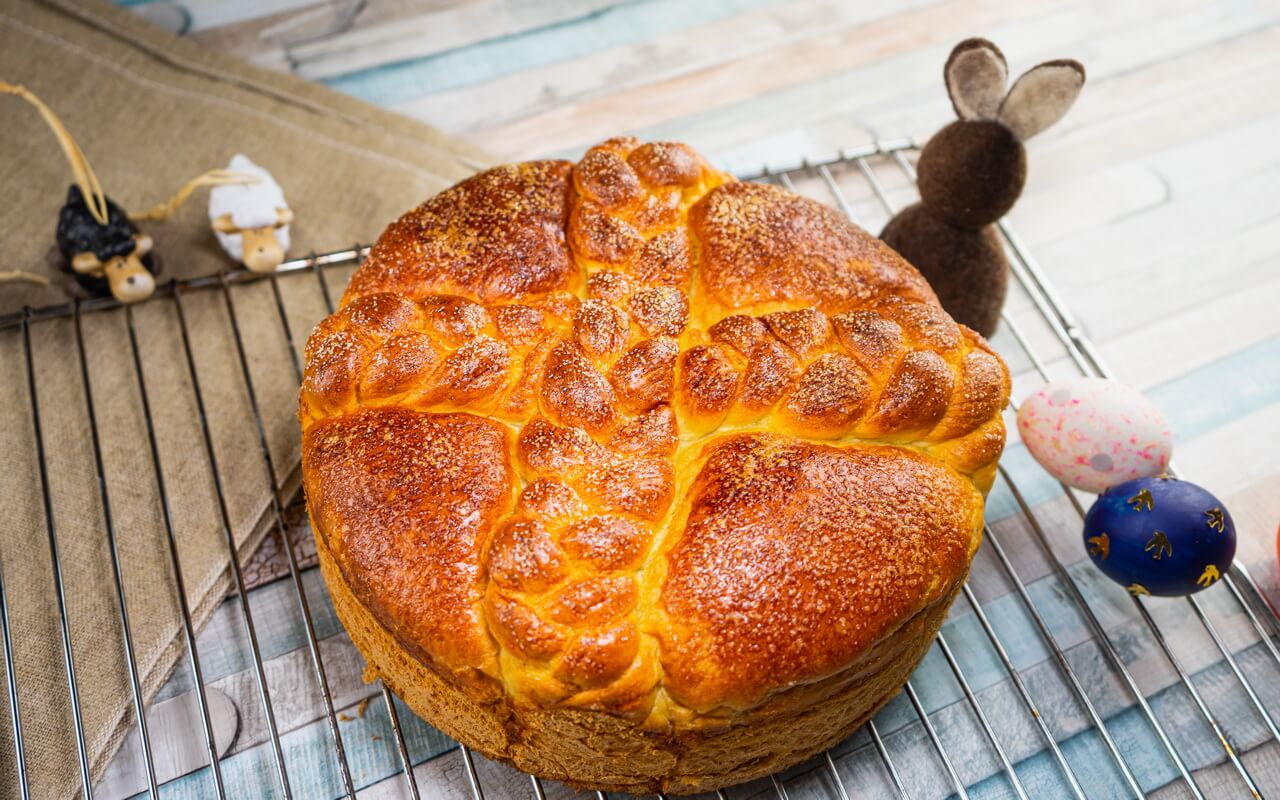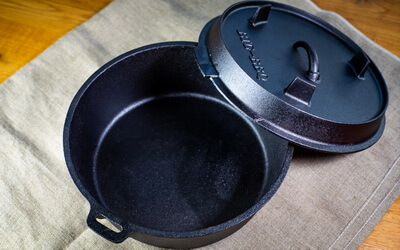After already baking an Italian Easter bread – Pane Di Pasque last year we were looking for another Easter Bread and came across this beautiful traditional Slovak Easter Bread called Paska.
Not only the looks of this sweet yeasted bread is fantastic but also the taste with its light sweetness makes this one perfect for an Easter brunch or Easter coffee, great for celebrations and taking some time for an extended breakfast on the balcony enjoying the sunshine.
Things to know before you start
Time Schedule
| Steps | Work time | Waiting time |
| Mix | ~15 minutes | – |
| Bulk Fermentation | ~5 minutes | 60-90 minutes |
| Grease baking pan | ~5 minutes | – |
| Shape | ~15 minutes | – |
| Proof | – | 45 minutes |
| Coat | ~10 minutes | – |
| Bake | ~5 minutes | 40-45 minutes |
| Cool | – | 60-90 minutes |
This Paska – traditional Slovak Easter bread will be ready to be eaten in under 5 hours.
Total ingredients
| Weight | Ingredient |
| 650 g | All-purpose flour |
| 62 g | White sugar |
| 15 g | Salt |
| 21 g | Yeast – Fresh |
| 255 g | Water |
| 120 g | Milk – 3,5% fat |
| 60 g | Butter |
| 3x | Eggs |
You will have a dough of about 1.350 g in total.
Difficulty
A pretty simple recipe. Only the shaping part could be a bit tricky if you havent made any braids with dough yet.
Baking tools
A 26 cm springform pan is needed or even a bit bigger one, but not a smaller one. You can also have a look at our should have baking tools to make your life easier for the whole baking process.
Steps
1. Mix
| Weight | Ingredient |
| 650 g | All-purpose flour |
| 50 g | White sugar |
| 15 g | Salt |
| 21 g | Yeast – Fresh |
| 240 g | Water – Lukewarm |
| 120 g | Milk – 3,5% fat |
| 60 g | Butter (softened) |
| 2x | Eggs |
- Mix all of the mentioned ingredients together with a stand mixer for 4 minutes on speed level one and 4 minutes on speed level two
- The dough should be pliable, not very sticky and bounce back when poked sllightly with your finger
2. Bulk Fermentation
- Take a big bowl and grease it lightly with butter until all sides are covered
- Cover the bowl and let it rest for a total of 60 to 90 minutes at 20-22°C (68-71,6°F) or until nearly doubled in size
- As we are using a high amount of fresh yeast, the dough will rise significantly as you can see in the pictures
3. Grease Baking Pan
- Grease a baking pan with butter on bottom and all sides
4. Shape
- Take the dough out on a lightly floured surface
- Divide it into 3/4 and 1/4
- Shape the 3/4 part of the dough into a smooth ball by rounding it and place it in the center of the previously greased baking pan
- Here is a short guide on how to create 2 braids of the 1/4 part of dough:
- Divide the dough into 6 small dough balls of the same weight
- Take 3 dough balls and roll each one to a cord of 22 to 25 cm
- Place 3 cords vertically from you next to each other
- Take the end of the middle cord, put it over the end of the cord on the left and press it together just a little bit
- Take the end of the right cord, put it over the end of both cords and also press it together just a little bit
- Take the left cord and cross it over the middle cord
- Take the right cord and cross it over the new middle cord
- Give the cords a gentle tug to tighten the cords as you braid
- Repeat steps 6 to 8 until you reach the end to create a braid
- Repeat steps 2 to 9 create the second braid
- Place the braids like a cross on top of the big dough ball
5. Proof
- Cover the dough with a kitchen towel
- Let it proof for 45 minutes at 20-22°C (68-71,6°F) or until nearly doubled in size
8. Cool
- Let your Paska – traditional Slovak Easter bread cool for 60 to 90 minutes in the baking pan
- After it is fully cooled you can remove the outer ring and start serving
Conclusion
Taste
This Paska – traditional Slovak Easter bread is so nicely soft and fluffy with a slight sweetness. Despite the high amount of used yeast for the dough you can barely taste it.
It has a fine crust of sugar on top which just rounds up the full and rich taste. The braided cross on top gives it a special look but you could as well only shape it as a loaf – just create it as you like or can.
Due to its own nice and sweet taste, you can either enjoy it with some honey, butter, marmalade or just eat this fluffy one as it is and enjoy a good cup of coffee or tea with it.






















XVII century was Nicholas Jarry [fr].